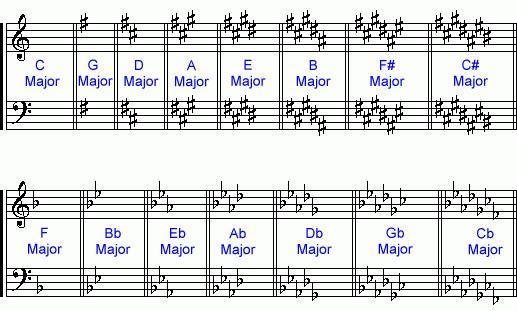Here's a myTake that offers a brief explanation on how music works and the basics and fundamentals of music theory.
Major and Minor

In music , it's usually major or minor; major and minor refers to the musical key.
In music, something having a major tonality gives it a "happy" sound, and a minor tonality gives it a "sad" sound.
Notes

Notes are in order in the alphabet corresponding to different pitches. The first note is A and the last note is G. There are sharps and flats too, which are also called accidentals (or the black keys on piano) and the term for the distance of notes across is "interval."
In order to create or play a melody, one would have to play notes.
Lead guitarists and wind instruments often play notes.
Key

The key refers to the scale or mode, the keys are letters of the alphabet, starting from A major to Gb minor are all possible keys. Keys can be either major or minor.
Key also define the sound of the song, as B minor sounds darker than the key of A major. Certain keys also have different moods.
Chords

A chord is a set of three or more notes harmonized together to sound full or in unison. Chords are derived and come from musical scales; these chords played on guitar are usually strummed across all six strings, while chords on piano are usually arpeggiated (which is a musical term for playing chords in a special sequence).
Scales and Modes

You may have heard of Do Re Ma Fi So, which is what singers practice to warm up their voice; it's actually a musical scale. A musical scale is basically a set of notes or pitch ordered in a scale, so singing Do Re Ma Fi is called solfège. Scales and modes are ordered in keys.
A scale is usually major or minor, so either "happy" or "sad" sounding, so C major Scale as depicted above has the notes the "c,d,e,f,g,a,b,c".
Rhythm and Melody and time signature

In music there are usually instruments such as bass, guitars and drums and piano. Bass carries the rhythm with the drums, while the guitars may play the melody along with the piano.
Melodies are usually simple note phrases, and rhythm is usually a rhythmic beat in time with the beat of the music.
Usually most pop, reggae, EDM and rock music is in 4/4 common time, which is the standard basis for most music these days.
Common time has four beats and four bars, so a count of 1 & 2 & 3 & 4 is what most modern music is written in on standard music tablature. Common time is a time signature and the most common of all time signatures, 2/4 being half time.
Octaves, Intervals and Consonance
In music, intervals is a term used to distinguish the notes from each other. Certain notes sound better together than others and this is called "perfect consonance". Common intervals or notes that sound good in harmonies would be the minor thirds and major third intervals.
In order to create harmony in a piece of music, the intervals or set of notes must be in consonance.
Octaves are basically the same note eight notes higher or lower in pitched, so an octave harmony would sound weird because it's basically the same note. Chords often have octaves of the same note twice.
Dissonant intervals or dissonance, is a term used to distinguish bad notes or out-of-tune notes that don't really go together.
The diminished fifth and tri-tones are examples of dissonant intervals.
Reading Music, Treble and Bass Clef

Reading music is not as complex as it seems, the lines refer to where notes are. As you climb the lines the note's pitch raises, as you go lower the notes go down in pitch. So a G note would be the 2nd line from the bottom.
And the 4/4 or numbers refer to the time signature or beat and tempo, while the fancy symbol on the left refers to the treble clef, which is higher register notes, whereas the other symbol refers to lower notes. Sheet music for guitar and piano differs, but generally guitar players will read tab or read tab that shows the guitarist which direction to play.
What Girls & Guys Said
Opinion
2Opinion
This is a great For Dummies guide. Playing piano helped me with learning the basics.
Dude, you are forgetting the most important aspect of music:
does it djent?
I thought it went without saying. Deep down, we are all truly djentlemen on the inside with an 8 string guitar tuned to drop E.
@dangerDoge
It's Ibanez RG386DXTRG450 or nothing
Gotta play dat Meshuggah haha
Share the first opinion in your gender
and earn 1 more Xper point!